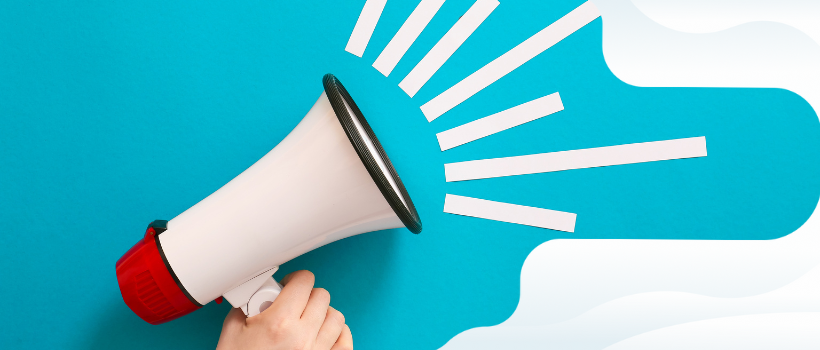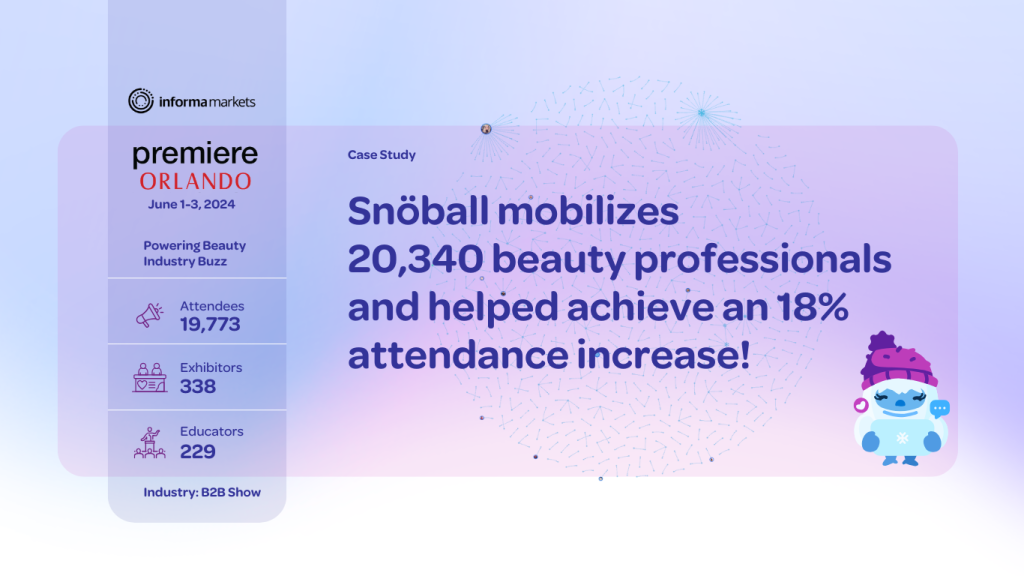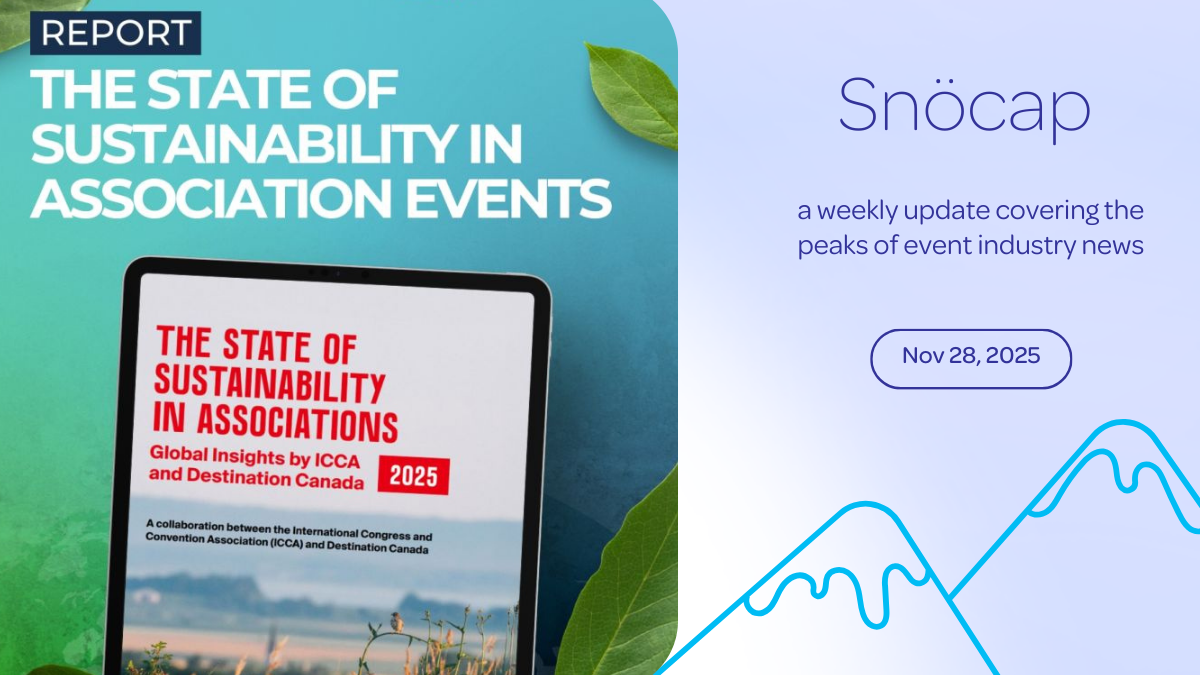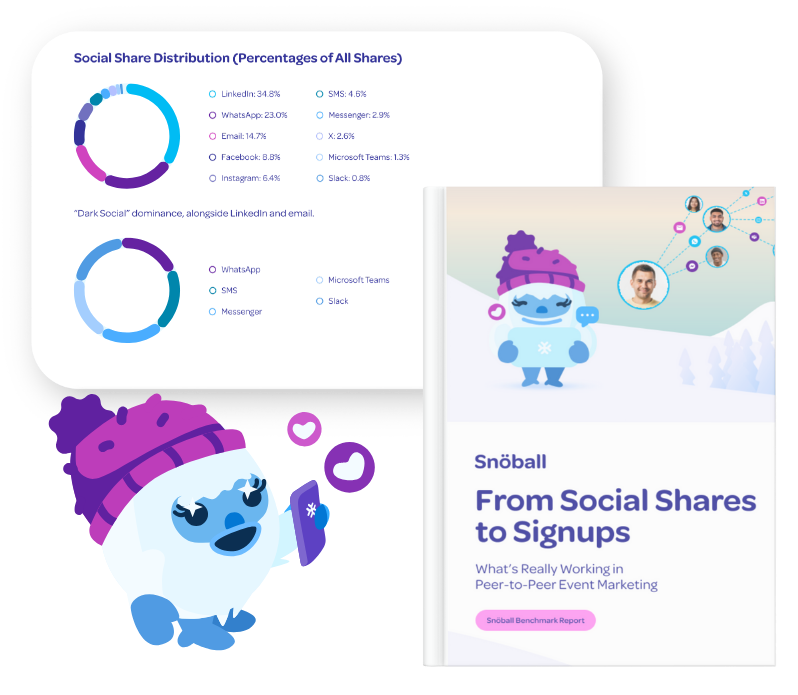The playbook for B2B event marketing is being rewritten.
Attendee acquisition and engagement strategies are being molded around peer advocacy programs built on trust. It’s all about driving real conversations, connections and credibility for your events through real people – your own audience.
According to Snöball’s Peer-to-Peer Event Marketing Benchmark 2024 report, peer-to-peer (P2P) marketing delivered one of the strongest results for events.
Nearly one-third of social shares and posts directly converted to registrations—making it a highly effective channel for event marketers.
As Kelly Hopping, CMO of DemandBase, says in the CMO Outlook Guide 2025:
“B2B buyers will be relying heavily on external influencers for guidance before making a purchase.
“Whether it’s social media, professional networks, industry experts or peer reviews, buyers are consulting at least 10 influencers during their decision-making process.
“If you’re not actively engaging with these voices and building relationships within these networks, you’re missing out on the conversations that shape buying decisions.”
This authentic peer influence is why peer advocacy works so effectively, especially in B2B events. However, understanding these strategies goes beyond typical “refer-and-reward” mechanisms.
That’s why we have created this playbook as a roadmap to:
- Learn what makes peer recommendations so powerful
- How to activate your event audience into your marketing advocates
- Which metrics matter in P2P marketing for B2B shows
You’ll discover why industry leaders like Informa and NHS are embracing P2P marketing, and learn practical steps to launch your own peer to peer marketing campaign using powerful referral marketing tools and strategies.
A quick look at what we will cover
- What’s P2P marketing in B2B events?
- P2P marketing vs traditional marketing in B2B events
- The psychology behind peer influence – why referrals matter
- Key P2P marketing strategies for B2B events
- Setting up a P2P event marketing campaign for B2B events
- Measuring success – which KPIs should you track?
- Challenges
- Case studies
- The future ahead
1. What is P2P marketing in B2B events?
P2P marketing in the B2B events world is pretty simple: it’s when your attendees, speakers, and exhibitors become your most powerful marketing champions.
Traditional marketing strategies include paid advertising, email marketing, sponsored content, and PR outreach. P2P marketing complements these efforts by adding a human layer—leveraging trusted relationships and professional networks to drive engagement.
It becomes a valuable part of the marketing mix by enabling direct, personal connections that build trust and spark genuine interest. It can be a healthcare professional who messages five colleagues saying, “You should register for this conference—their patient data security workshop solved our biggest compliance headache.” Or it could be a keynote speaker sharing a personal invite for her session to a network of 20,000 LinkedIn followers.
What makes P2P uniquely powerful in B2B events is the trust factor.
When a peer recommends an event, they’re lending their credibility to your marketing efforts. And the numbers don’t lie: Snöball’s Peer-to- Peer Marketing Benchmark Report found that 31.72% of social shares by stakeholders converted into registrations. When someone received a direct personal invitation from a peer, that number jumped to 37%—conversion rates that traditional marketing channels can only dream about.
P2P marketing isn’t new—word-of-mouth has always been valuable—but what’s changed is our ability to systematically encourage, track, and amplify it. Today’s event organizers use specialized platforms like Snöball to create personalized landing pages for advocates, offer trackable referral links, measure which peer channels drive the most registrations and identify top advocates.
The practical applications span the full event lifecycle, from pre-event buzz to post-event engagement. These can include everything – from formal referral programs (“Bring a colleague, you both save 20%”) to speaker advocacy toolkits to user-generated content campaigns. What unites these tactics is leveraging the authentic enthusiasm of your community instead of relying solely on your marketing team’s efforts.
How does P2P event marketing differ from traditional marketing methods for exhibitions and associations? Let’s dive in.
2. P2P marketing vs traditional marketing in B2B events
Traditional B2B marketing is often business-centric – email blasts, ads, and sales outreach are all targeted towards driving transactions and closing deals.
In contrast, P2P marketing is people-centric.
Let’s cut through the noise and see what the numbers reveal.
The conversion gap
Traditional approaches cast wide nets with meager returns: email campaigns convert at 1-3%, while digital ads struggle to break 2% for click-throughs (Marketing Benchmarks Report, 2024).
P2P marketing tells a different story: nearly one in five recipients of peer-shared event invitations convert to registrants based solely on that referral, according to Snöball’s benchmark report.
Trust: the ultimate currency
The trust equation explains everything. Edelman’s Trust Barometer consistently shows we trust “people like us” far more than corporate messaging. This translates directly to purchasing behavior, with 73% of B2B buyers influenced by word-of-mouth (Wynter, The B2B Buyer Journey Research: How B2B SaaS Marketing Leaders Buy Software in 2024).
Why? Peer recommendations come with built-in credibility.
When your industry friend says “this conference changed our approach,” it carries the weight of shared experience—something no polished marketing email can deliver.
Channel performance
Not all peer influence channels are created equal. Snöball’s Peer-to-Peer Marketing Benchmark Report breaks down the numbers:
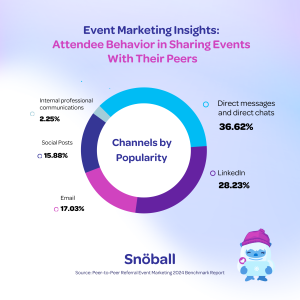
3. The psychology behind peer influence – why referrals matter
Trust and credibility: the quiet handshake
Trust in B2B marketing can’t be manufactured—it’s earned through genuine relationships. When professionals see trusted industry figures promoting an event, that endorsement carries weight no paid advertising can match.
Data consistently shows we’re wired to believe people we respect over institutional messaging. This explains why attendees are significantly more likely to register when they see a respected analyst, thought leader, or colleague sharing their plans to attend.
The trust transfer is automatic and powerful – “If this person finds value in this event, I probably will too.” What makes these peer endorsements so effective is their perceived objectivity.
Social proof and FOMO
When your LinkedIn feed fills with industry peers talking about the same event, you’re seeing social proof in action. FOMO in B2B isn’t about missing a party—it’s a realization that competitors might gain knowledge or connections you won’t have.
We pretend business decisions are purely rational, but often we’re simply following people we respect. Nobody wants to be the last to know where the industry’s headed.
As Nancy Harhut says in her book Using Behavioral Science in Marketing:
“Make no mistake about it, fear sells. People do not want to lose out. Sales can go up when people fear they will miss a good deal, or when they fear a product may run out, or if they fear they will be less popular, pretty, sexy, or socially accepted if they don’t own the trendy new item.”
Advancing B2B decision making
B2B decisions rarely happen in isolation.
People consult their teams, bosses, and industry contacts before committing to events.
According to Inbox Insight’s B2B Tech Buying Behavior 2024 Report, 42% of B2B decision-makers consult 4-6 sources of information when researching a purchase, with peer recommendations and industry insights ranking among the most trusted inputs.
All that marketing spend, and what often seals the deal is a simple message: “This was actually worth my time.” When your speakers and attendees talk about your event, you’re tapping into those hidden networks where the real decisions happen—the places where people ask “Should I go?” and get honest answers.
Referrals bring joy
Recommending something valuable to your network feels good.
The recommender gets to be the expert, while the recipient feels that someone thought specifically about their needs—far better than receiving another generic marketing email.
People who come through recommendations tend to arrive with better attitudes, participate more actively, and more often return the following year, becoming event ambassadors themselves.
4. Key P2P marketing strategies for B2B events
Turning your audience into your event marketers doesn’t just mean slapping a “please share” button at the end of registration. It’s about giving them the right stuff to share, when they’re most excited to share it.
For example, when someone signs up as a speaker or registered for your event, they feel a rush of excitement. That’s when you want to hand them those easy-to-personalize social posts, eye-catching graphics, and little nudges along the way.
Here are some ways you can build your P2P event marketing campaign:
Build your advocate network
- Formalize ambassador programs
Recruit past attendees who spark genuine enthusiasm. Equip them with exclusive content and early access perks. - Develop tiered incentives
The more peers they bring, the better their rewards. Think VIP experiences, not just discounts. - Train your advocates
Brief sessions on key messaging equip them to speak authentically while hitting your core value points.
Engineer shareable moments
- Craft social spaces for snaps
Design event spaces specifically for LinkedIn-worthy photos that subtly showcase your branding. - Create content stations
Set up areas where attendees can record quick testimonials or insights to share within their networks. - Offer digital swag
Provide unique, valuable content that’s easy to consume and forward to colleagues.
Leverage professional communities
- Market yourself on community channels
Don’t just promote—contribute valuable insights that position your event as unmissable. - Partner with niche professional groups
Their endorsement carries significant weight with exactly the right audience. - Create micro-communities
Develop small, focused groups around specific industry challenges that your event addresses.
Harness social proof at scale
- Deploy dynamic testimonial feeds
Real-time social media feeds can be deployed on the event website and landing pages. These create a social wall that showcases attendee experiences to create FOMO among their connections. - Showcase attendee metrics prominently
“Join 87% of industry CTOs” hits harder than generic value propositions. - Feature peer success stories
Short video testimonials highlighting tangible outcomes from past events convert skeptics.
Activate dark social
- Enable private sharing tools
Make it frictionless for attendees to invite peers through direct messages or emails. - Create “whisper campaigns”
Seed exclusive information to select influencers who will naturally share within closed networks. - Develop referral tracking mechanisms
Measure what happens in private channels to refine your approach.
According to Snöball’s Peer-to-Peer Marketing Benchmark Report, 38.9% of referral shares by event advocates were done on dark social channels (direct messages, chats and internal comms)
5. Setting up a P2P event marketing campaign for B2B events
Here’s how to set up an effective P2P campaign using Snöball’s solution.
1. Map your goals + segments
Start by defining what “success” looks like (registrations, ticket revenue, exhibitor leads, etc.) and decide who you want to mobilise: speakers, exhibitors, attendees, partners, or all of the above. Snöball groups these audiences into discrete segments so messages and rewards feel personal from the very first share.
2. Centralise data & integrations
Great P2P programs sit on top of the tools you already use. Snöball plugs into 70-plus registration, CRM, and email platforms, so advocate activity writes straight back to your source of truth—no spreadsheets required.
3. Give every advocate a toolkit that’s ridiculously easy to share
Once your lists are synced, auto-generate personalised landing pages, social graphics, email copy, and trackable links for each advocate.
They stay on-brand because you can bring your own design or let Snöball style them for you. One click and your people have a post ready for LinkedIn, X, WhatsApp, Slack, or 10+ other channels.
4. Automate the nudge sequence
Schedule booster emails and in-platform prompts that hit inboxes just before key deadlines (“Early-bird ends Friday—share now!”).
A tiny push at the right moment can double share volume, and Snöball’s social-sharing widget lets advocates post without even leaving your site or email.
5. Track, reward, repeat
Real-time dashboards surface top advocates, the social channels driving the most traffic, and the exact conversion rate of every share.
Use that intel to spotlight winners on your event feed, drop swag, or unlock VIP perks—positive reinforcement that keeps the snowball rolling.
6. Measuring success – which KPIs should you track?
Here are some common metrics to help you track your wins and areas of improvement in a P2P event marketing program:
- Referral Registrations
These are the tangible results of peer trust—each sign-up a testament to a recommendation’s power. Data shows 31.7% of advocate shares convert to registrations, contributing 7% of total attendees (2024 P2P Event Benchmark Report). It’s proof that personal endorsements drive action.
- Advocate Participation Rate
This measures your ability to rally advocates. If 30 out of 50 advocates promote your event, that’s a 60% participation rate—a clear indicator of your event’s appeal and ease of advocacy.
- Traffic from Peer Promotions
Monitor the clicks from shared posts—each one a signal of interest sparked by credibility.
Snöball’s Peer-to-Peer Marketing Benchmark Report highlights a 51% increase in visibility through P2P efforts, reflecting genuine engagement over paid reach.
- Social Mentions
Track how often your event hashtag appears online—it’s a barometer of organic buzz, showing your event’s resonance in digital conversations. - Engagement & NPS
Peer-referred attendees often show higher engagement—measure their post-event Net Promoter Score (NPS) to gauge satisfaction. - Conversions Beyond Attendance
Assess how peer-referred attendees convert—into leads, deals, or members—demonstrating the long-term value of trusted connections.
How to track:
- Unique links/codes
Equip advocates with distinct links or codes to trace registrations back to their efforts—think of it as a digital fingerprint for each referral. - Registration questions
Include a field like “How did you hear about us?” to capture peer-driven sign-ups with precision. - Promo codes
Use shareable codes for offline referrals, ensuring even verbal recommendations are measurable. - Surveys
Post-event, ask attendees, “What influenced your attendance?” to uncover insights tracking might miss. - Social listening
Participate and engage in community chatter and acknowledge the effort of people to promote the event.
With P2P marketing solutions, you’re able to measure how trust works in numbers. These metrics reveal how peer influence outshines traditional tactics, turning recommendations into results.
7. Challenges
1. Over-reliance on willing participants
One common pitfall is assuming all stakeholders will happily promote the event.
In reality, many won’t take initiative unless prompted effectively.
Solution
Make advocacy frictionless. Provide one-click share links, draft messages, and clear instructions. Ensure to send timely reminders with actionable CTAs to keep the buzz going. Communicate “what’s in it for them” and get early wins to encourage others to participate.
2. Spammy or inauthentic outreach
There’s a fine line between encouraging peer invites and creating spam.
If every speaker blasts the same templated message, it can feel forced and damage credibility.
Solution
Encourage personalization.
Provide templates as guides but urge advocates to add their voice.
Remind them to only share with people for whom the event is relevant.
3. Neglecting attribution and credit
Failing to track P2P marketing properly can lead to under appreciation of its value and demotivate advocates.
Solution
Set up attribution from the start and recognize advocates’ efforts.
A simple thank-you email is the bare minimum while public recognition along with actual rewards (vouchers, discounts, free tickets to next year’s event) is the recommended way.
Privacy and data concerns
As privacy regulations increase, peer marketing must navigate potential issues around contact sharing and data usage.
8. Case studies
Informa Premiere Show
When Informa Markets partnered with Snöball to transform their approach to marketing Premiere Orlando, they turned 20,340 beauty professionals into brand advocates by extending their P2P campaign timeline from just a few weeks to three months.
This strategic shift gave their advocates—including attendees, educators, and exhibitors—the runway to build authentic momentum within their professional networks.
Campaign Highlights:
- 20,340 beauty professionals mobilized (19,773 attendees, 229 educators, 338 exhibitors)
- 122% increase in social shares (4,000 total shares)
- 6x ROI on campaign investment
- 18% increase in event attendance year-over-year
Through strategic pre-campaign analysis and targeted influencer incentives, Premiere Orlando proved that equipping your audience with the right tools can deliver results that traditional marketing channels usually can’t match.
NHS ConfedExpo
NHS Confederation’s three-year partnership with Snöball is another example of the compounding power of community-driven promotion – this time for the healthcare sector.
For their 2024 Manchester event, they implemented a planned 19-week campaign that mobilized 6,712 healthcare professionals through 18 strategically timed reminder campaigns using Snöball’s P2P marketing platform.
Campaign Highlights:
- 6,712 healthcare professionals mobilized (6,034 attendees, 562 speakers, 116 exhibitors)
- 930+ delegate bookings directly attributable to peer recommendations
- 81.97% advocate adoption rate
- 36.28% conversion rate from social shares
- 6x ROI on campaign investment
The campaign’s success was rooted in its authentic approach to healthcare communications, using non-monetary motivation systems and personalized promotional materials.
By timing campaigns around key milestones like agenda launches and countdown markers, NHS ConfedExpo transformed their stakeholders into a marketing force that delivered registrations traditional channels would have missed.
9. The future ahead
The numbers tell the story—P2P marketing delivers for B2B events.
A 51% boost in visibility and conversion rates of 31.7% – without breaking the bank – according to Snöball’s 2024 P2P Events Benchmarking report.
AI is transforming the marketing landscape at a breakneck speed, so expect smarter tools that spot your best event advocates and amplify their voices. And advanced tracking tools that connect peer conversations and connections directly to revenue, giving clear visibility into ROI.
As more B2B event buyers tune out ads and seek trusted perspectives, peer-to-peer marketing – with its natural authenticity and credibility – becomes the key to cracking the code for successful event marketing strategies.

